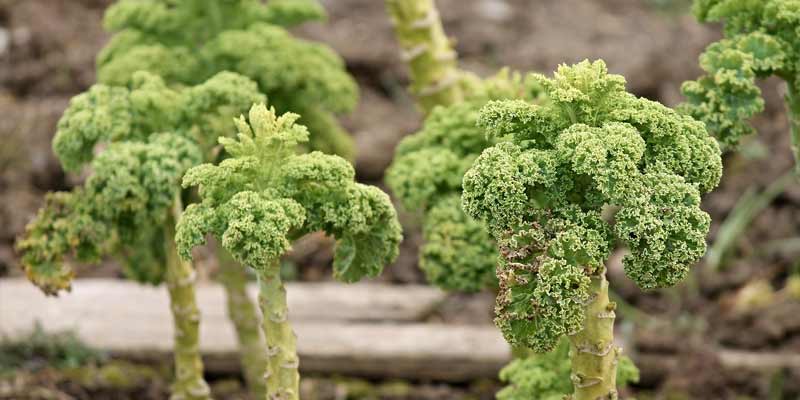The immense popularity of Kale, a nutritionally rich leafy green, arises from its health benefits and versatile nature in culinary applications. Understanding the space requirements for kale growth is essential to cultivating an abundant harvest whether you possess a seasoned gardener’s expertise or merely the aspirations of someone with a “green thumb.”
This article delves into factors that influence these spatial needs: optimal planting distances; and tips to enhance your yield from kale, a truly remarkable plant indeed!
Understanding Kale’s Growth Habit
The robust and hardy nature of Kale (Brassica oleracea), a member of the cabbage family, is well-known. Understanding kale’s growth habit requires us to grasp its spatial requirements.
Usually, kale develops a compact rosette of leaves radiating from its central stem. Kale, with its vertical growth, thrives in space-limited gardens, unlike certain sprawling plants.
Factors Influencing Kale’s Space Requirements
1. Variety of Kale
Various kale varieties possess unique characteristics and growth habits. For instance, compact types such as Dwarf Blue Curled and Lacinato – or Dinosaur Kale require less space than their larger counterparts like Russian Red or Siberian Kale.
Therefore, when you plan the layout of your kale patch: take into account the specific variety you are growing.
2. Soil Quality and Nutrients
The soil’s role in kale growth is crucial, particularly when it comes to well-draining and organically enriched earth. Adequate soil fertility guarantees that plants receive vital nutrients for robust development; this may also influence their overall space requirements.
3. Sunlight Exposure
Full sunlight enables kale to thrive, yet it also tolerates partial shade. Your garden’s sunlight intake may determine the compactness or stretch of your kale plants: robust leaves develop with an essential requirement for adequate sunlight.
Optimal Planting Distances for Kale
Different kale varieties require varying planting distances to achieve optimal growth; the recommended spacing, indeed, hinges on both variety and specific growing conditions. Consider these general guidelines–they will aid you in determining:
1. Compact Varieties (Dwarf Blue Curled, Lacinato):
– Plant spacing: 12-18 inches apart in rows.
– Row spacing: 18-24 inches between rows.
2. Medium-Sized Varieties (Red Russian, Siberian Kale):
– Plant spacing: 18-24 inches apart in rows.
– Row spacing: 24-30 inches between rows.
3. Large Varieties (Winterbor, Nero di Toscana):
– Plant spacing: 24 inches apart in rows.
– Row spacing: 30 inches between rows.
The recommended spacing ensures each kale plant develops without crowding, thereby enabling proper air circulation and sunlight exposure; moreover, this adequate spacing promotes ease of harvesting, a crucial factor in reducing the risk of diseases that tend to proliferate under crowded conditions.
Tips for Maximizing Kale Yield in Limited Space
1. Successive Planting
Consider employing a strategy of successive planting. for your kale, rather than sowing all the seeds or transplanting all the seedlings at once. This method necessitates the placement of small batches—either seeds directly or pre-grown plants—at periodic intervals; by doing so, you guarantee an uninterrupted harvest throughout each growing season.
Those with limited space particularly benefit from this approach will facilitates a more efficient utilization of their available area.
2. Container Gardening
Consider growing kale in containers if space significantly constrains you. Compact and dwarf varieties of kale, they are perfectly suited for container gardening; therefore, opt specifically for these options.
Ensure the containers possess adequate drainage, a crucial step to avoid waterlogging; moreover, use a potting mix that is rich in nutrients.
3. Vertical Gardening
Maximize your vertical space and grow kale in a vertical manner. Utilize trellises or other designated structures to provide support for climbing variants of the vegetable; by doing so, you not only increase spatial efficiency, but also introduce an intriguing dimension into your garden.
4. Companion Planting
Enhanced growth and overall health of kale can result from planting it alongside compatible companion plants: for instance, tomatoes or peppers provide shade during the hottest part of the day.
Conclusion
Conclusively, one must grasp the criticality of understanding kale’s spatial requirements for a prosperous and plentiful harvest. Factors including kale variety; soil quality, as well as sunlight exposure, which all influence determining optimal planting distances.
By adhering to suggested spacing guidelines, and incorporating methods such as successive planting – container gardening or vertical gardening–you can prolifically yield your kale even in confined spaces.



